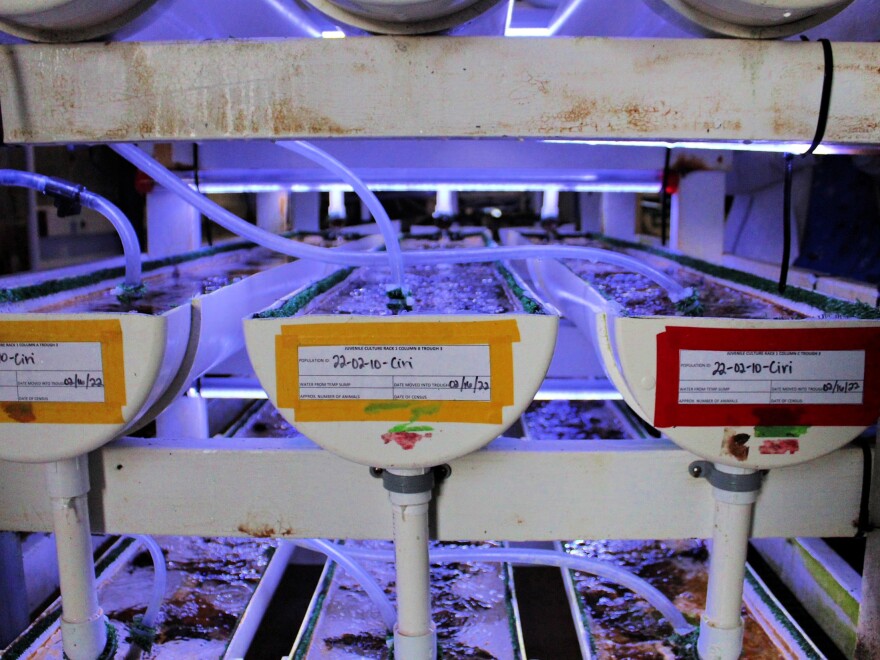Kristin Aquilino stands outside a locked black door that has a sign that reads, "Authorized Personnel Only."
"You're about to enter a room that has more white abalone than exist in the ocean, which is both terrifying and an incredible opportunity to save them," she says.
Aquilino runs the white abalone captive breeding program at UC Davis Bodega Marine Laboratory in California.
"I basically manage a really specialized fertility clinic, spa and nursery for an endangered sea snail," she says.

/ Nick Campbell
/
Nick Campbell

/ Nick Campbell
/
Nick Campbell
This was not exactly Aquilino's childhood dream. She admits she didn't know what an abalone was until she arrived in California as a grad student. But she learned quickly.
There are seven species native to the Californian coast, and in 2001, white abalone became the first marine invertebrate to be listed as endangered. White abalone have the bad luck of being known as the most tender and delicious, and in the 1970s they were fished nearly to extinction.
Today, diving for wild abalone is prohibited in California. There are commercial abalone farms, but Aquilino and her team have been working since 2011 to get enough animals into the ocean to remove the species from the endangered list.
"I could not have imagined as a kid growing up in Iowa that I would be in charge of saving an endangered sea snail," Aquilino says.

/ Chad Campbell
/
Chad Campbell
The 20,000 or so abalone in her lab range drastically in age and size. In the "juvenile culture rack" the smallest hatchlings are just a few hundred microns across — about the size of a speck of vanilla bean in your fancy ice cream.
It takes two to four years in the lab for the abalone to go from a speck to the inch-long juveniles ready to be introduced to the ocean. In another tank are 21-year-olds that were spawned during the very first year of the program (Aquilino's best guess is that abalone can live 40 years or more in the wild.)
The 10 biggest animals in the lab were captured between 2004 and 2019 and are now a bit bigger than a softball. But these seniors can't retire yet — Aquilino says they're some of her most prolific spawners. She points to "Green 312" clinging to the side of a tank.

/ Chad Campbell
/
Chad Campbell

/ Chad Campbell
/
Chad Campbell
"There's a special animal in here," she says. "She's one of the animals who've spawned most in this program. She's spawned 20 million eggs at one time. And that's our hope to get all these animals to spawn that much regularly."
So, how do the researchers convince the animals to make babies?
"Spawning white abalone is a really romantic process," Aquilino says. "We put them all in their own individual buckets. We put a love potion of hydrogen peroxide in those buckets, play some Barry White and hopefully they give us whatever gametes they have."
Aquilino says the researchers have in fact played Barry White's hit "Can't Get Enough of Your Love, Babe" in the lab during spawning season. Why not? It couldn't hurt.
"The scientists need to be in the mood too, I suppose," she chuckles.

/ Nick Campbell
/
Nick Campbell
There are other labs around the world doing similar work, but what makes this one special is the fact it's located right at the core of the ocean upwelling, says lab director John Largier.
California is one part of the world where the cold, nutrient-rich water rises close to the surface. It happens in southwestern Africa — where Largier is from — as well as northwestern Africa into southern Europe, and all along the west coasts of South and North America.
Largier says all of those regions share the same desirable attributes.
"They're all characterized by bounteous fish, big birds, sharks, whales — and inland, really good wine," he says.
As for the work they are doing to bring abalone back from the brink of extinction, that will take some time, Aquilino says. The lab is creating about 30,000 white abalone a year, but she believes they need to triple that number.
"It's probably going to take decades in order to create self-sustaining populations [in the wild]," she says. "If we can keep putting animals in the same site four times a year or so for five or six years, the hope is we can create those self-sustaining populations."
That work is well underway, and her lab already produces more animals than it can store.
As she prepares to leave the lab, Aquilino receives a text from the hatchery manager at an abalone farm that partners with the lab. It reads, "The future of white abalone," and includes two pictures of troughs overflowing with her animals — ready to try their luck in the open ocean for the first time.
Copyright 2022 NPR. To see more, visit https://www.npr.org.
"behind" - Google News
July 29, 2022 at 04:00PM
https://ift.tt/THZd5ck
Behind this locked door is the white abalone's best chance of avoiding extinction - knkx.org
"behind" - Google News
https://ift.tt/8nxSQgR
https://ift.tt/dPWJj1B
Bagikan Berita Ini














0 Response to "Behind this locked door is the white abalone's best chance of avoiding extinction - knkx.org"
Post a Comment